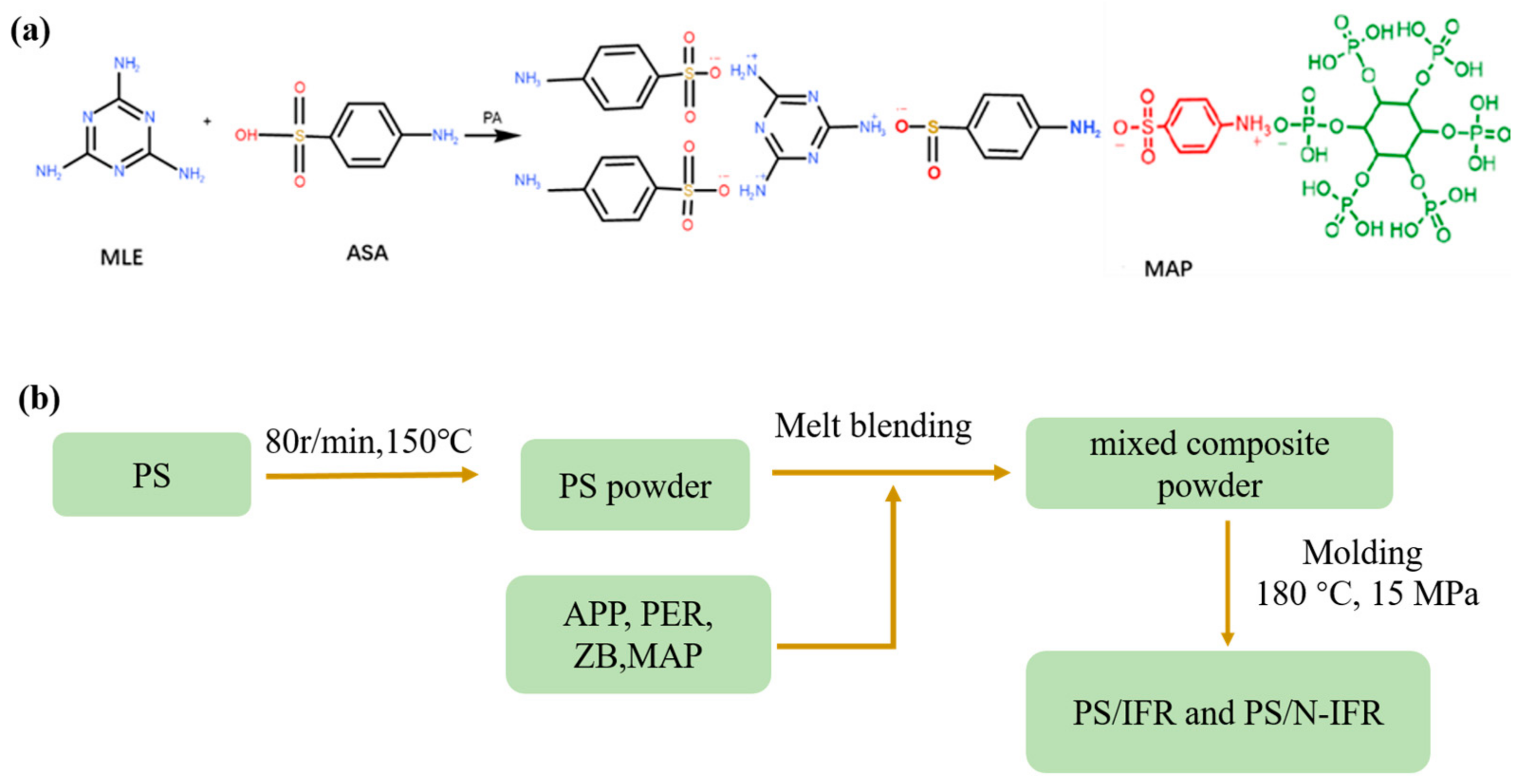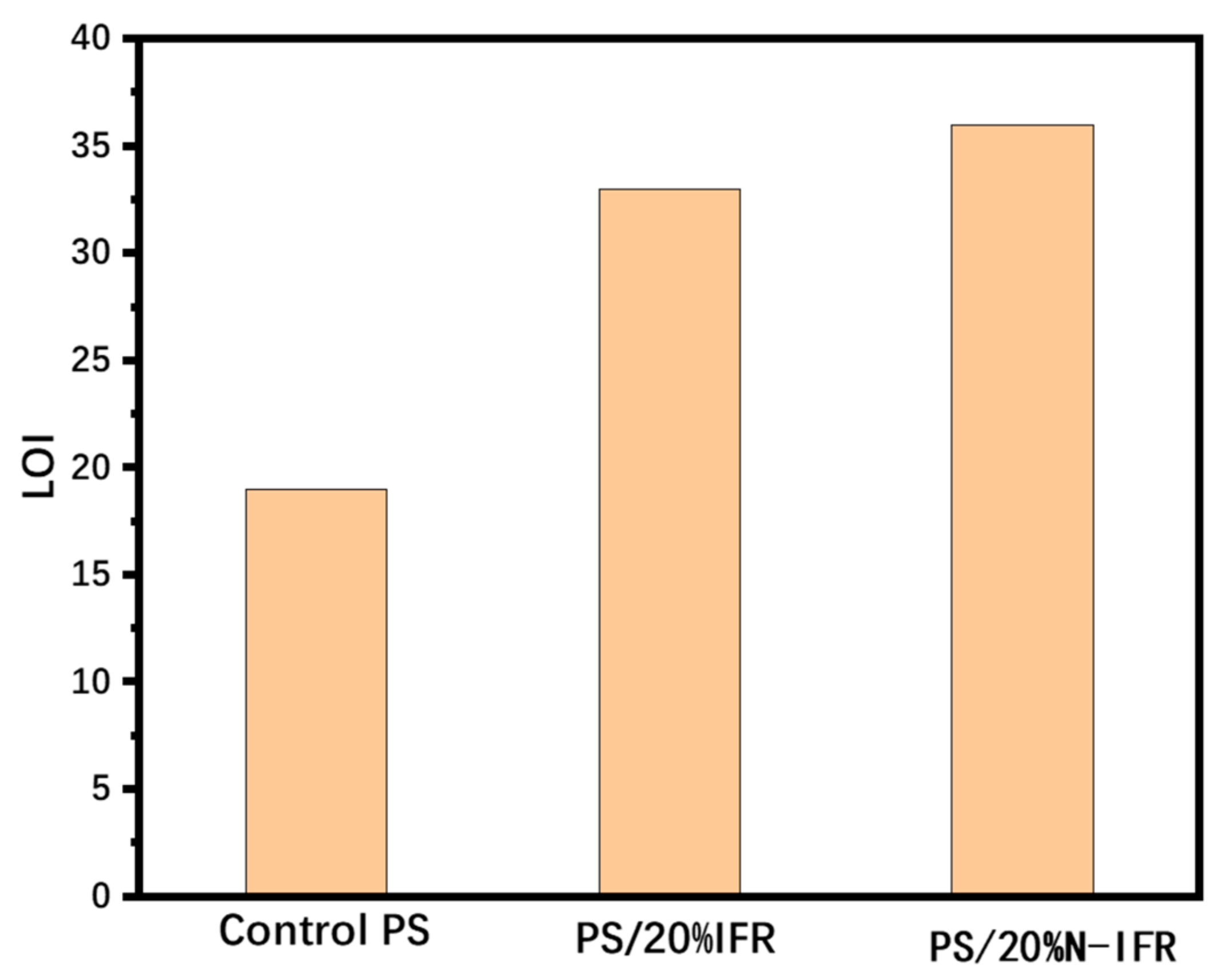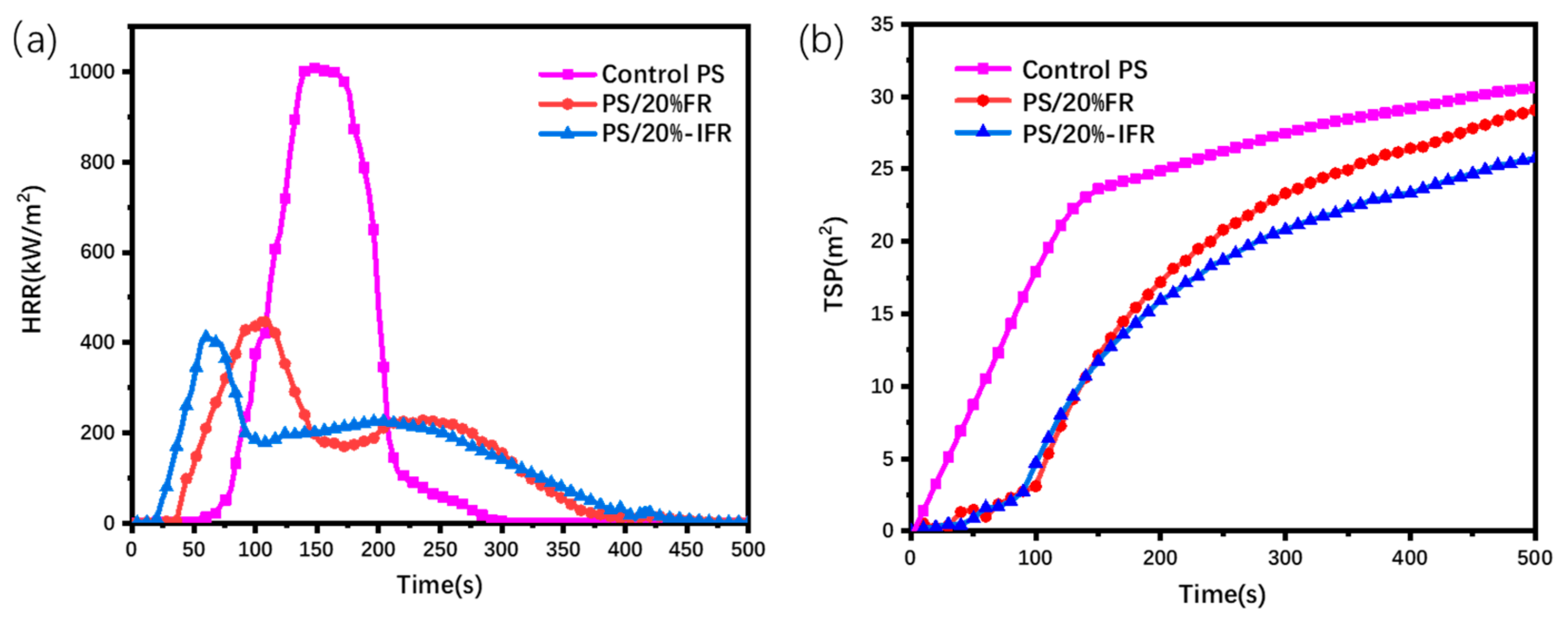Preparation of a New Type of Expansion Flame Retardant and Application in Polystyrene
Abstract
1. Introduction
2. Materials and Methods
2.1. Materials
2.2. Preparation of a New Type of Expansive Flame-Retardant MAP
2.3. Preparation of Expanded Flame-Retardant Polystyrene
2.4. Characterizations
3. Results and Discussion
3.1. Chemical Structure Analysis
3.2. Flame Retardancy Analysis of PS/IFR Composites
3.3. Cone Calorimetry Test
3.4. Cone Calorimetric Residual Carbon Analysis
3.5. Mechanics Performance Testing
4. Conclusions
Author Contributions
Funding
Institutional Review Board Statement
Informed Consent Statement
Data Availability Statement
Conflicts of Interest
References
- Alaee, M.; Wenning, R.J. The Significance of Brominated Flame Retardants in the Environment: Current Understanding, Issues and Challenges. Chemosphere 2002, 46, 579–582. [Google Scholar] [CrossRef] [PubMed]
- Schinazi, G.; Moraes d’Almeida, J.R.; Pokorski, J.K.; Schiraldi, D.A. Bio-Based Flame Retardation of Acrylonitrile–Butadiene–Styrene. ACS Appl. Polym. Mater. 2021, 3, 372–388. [Google Scholar] [CrossRef]
- Liu, J.-C.; Xu, M.-J.; Lai, T.; Li, B. Effect of Surface-Modified Ammonium Polyphosphate with Kh550 and Silicon Resin on the Flame Retardancy, Water Resistance, Mechanical and thermal Properties of intumescent Flame Retardant Polypropylene. Ind. Eng. Chem. Res. 2015, 54, 9733–9741. [Google Scholar] [CrossRef]
- Zhu, Z.-M.; Xu, Y.-J.; Liao, W.; Xu, S.; Wang, Y.-Z. Highly Flame Retardant Expanded Polystyrene Foams from Phosphorus-Nitrogen-Silicon Synergistic Adhesives. Ind. Eng. Chem. Res. 2017, 56, 4649–4658. [Google Scholar] [CrossRef]
- Choi, S.-S.; Kim, J.-C.; Lee, H.-M. Analysis of Origin To Cause Blowout of Carbon Black-Reinforced Rubber Composites Using Gc/Ms. J. Appl. Polym. Sci. 2008, 110, 3068–3072. [Google Scholar] [CrossRef]
- Bhebhe, M.N.; De Eulate, E.A.; Pei, Y.; Arrigan, D.W.M.; Roth, P.J.; Lowe, A.B. Reactive Conjugated Polymers: Synthesis, Modification, and Electrochemical Properties of Polypentafluorophenylacetylene (Co)Polymers. Macromol. Rapid Commun. 2017, 38, 1600450. [Google Scholar] [CrossRef]
- Zheng, T.; Wang, W.; Liu, Y. A Novel Phosphorus-Nitrogen Flame Retardant for Improving the Flame Retardancy of Polyamide 6: Preparation, Properties, and Flame Retardancy Mechanism. Polym. Adv. Technol. 2021, 32, 2508–2516. [Google Scholar] [CrossRef]
- Maghfouri, M.; Alimohammadi, V.; Gupta, R.; Saberian, M.; Azarsa, P.; Hashemi, M.; Asadi, I.; Roychand, R. Drying Shrinkage Properties of Expanded Polystyrene (Eps) Lightweight Aggregate Concrete: A Review. Case Stud. Constr. Mater. 2022, 16, e00919. [Google Scholar] [CrossRef]
- Ferrandez, D.; Alvarez, M.; Saiz, P.; Zaragoza, A. Experimental Study with Plaster Mortars Made with Recycled Aggregate and thermal insulation Residues for Application in Building. Sustainability 2022, 14, 2386. [Google Scholar] [CrossRef]
- Yan, H.; Zhang, J.; Zhang, M.; Du, X.; Ma, S.; Xu, B. Synergistic Flame-Retardant Effect of Ifr and Ppo in Improving Flame Retardancy of Polystyrene. Adv. Polym. Technol. 2016, 35, 208–214. [Google Scholar] [CrossRef]
- Wu, Z.; Yang, L.; Zhan, J.; Chen, Y.; Zhou, X.; Hu, Y.; Stec, A.A.; Hull, T.R. Experimental Study on Polystyrene with intumescent Flame Retardants from Different Scale Experiments. Fire Mater. 2016, 40, 18–26. [Google Scholar] [CrossRef]
- Savas, L.A.; Arslan, C.; Hacioglu, F.; Dogan, M. Effect of Reactive and Nonreactive Surface Modifications and Compatibilizer Use on Mechanical and Flame-Retardant Properties of Linear Low-Density Polyethylene Filled with Huntite and Hydromagnesite Mineral. J. Therm. Anal. Calorim. 2018, 134, 1657–1666. [Google Scholar] [CrossRef]
- An, M.; Wu, X.; Li, H. Short Review of Phosphorus-Containing Flame Retardant Poly (Lactic Acid). Plastics 2022, 51, 48–54, 70. [Google Scholar]
- Howell, B.A.; Daniel, Y.G. Incorporation of Comonomer Exo-5-(Diphenylphosphato)Isosorbide-2-Endo-Acrylate To Generate Flame Retardant Poly(Styrene). Polymers 2019, 11, 2038. [Google Scholar] [CrossRef]
- Guo, Y.; Zheng, Y.; Zhang, H.; Cui, J.; Guo, J.; Yang, B. Butyltriphenylphosphine-Based Chelate Borates influenced on Flame Retardancy of Polystyrene Composite Containing Self-Expanded intumescent Flame Retardants. J. Appl. Polym. Sci. 2021, 138, 50650. [Google Scholar] [CrossRef]
- Anh Quoc, H.; Karyu, R.; Nguyen Minh, T.; Goto, A.; Tuyen, L.H.; Matsukami, H.; Suzuki, G.; Takahashi, S.; Viet, P.H.; Kunisue, T. Comprehensive Characterization of Halogenated Flame Retardants and Organophosphate Esters in Settled Dust from informal E-Waste and End-of-Life Vehicle Processing Sites in Vietnam: Occurrence, Source Estimation, and Risk Assessment. Environ. Pollut. 2022, 310, 119809. [Google Scholar] [CrossRef]
- Lee, H.-K.; Bak, G.; Lim, J.-E.; Lee, J.-W.; Lee, S.; Moon, H.-B. Historical Record of Legacy and Alternative Halogenated Flame Retardants in Dated Sediment from A Highly industrialized Saltwater Lake in Korea. Chemosphere 2022, 297, 134264. [Google Scholar] [CrossRef] [PubMed]
- Ma, Y.; Ma, P.; Ma, Y.; Xu, D.; Wang, P.; Yang, R. Synergistic Effect of Multiwalled Carbon Nanotubes and An intumescent Flame Retardant: Toward An Ideal Electromagnetic interference Shielding Material with Excellent Flame Retardancy. J. Appl. Polym. Sci. 2017, 134, 45088. [Google Scholar] [CrossRef]
- Li, D.; Li, C.; Jiang, X.; Liu, T.; Zhao, L. Synergistic Effects of intumescent Flame Retardant and Nano-Caco3 on Foamability and Flame-Retardant Property of Polypropylene Composites Foams. J. Cell. Plast. 2018, 54, 615–631. [Google Scholar] [CrossRef]
- Nie, S.; Liu, L.; Dai, G.; Zhou, C. Investigation on Pyrolysis of intumescent Flame-Retardant Polypropylene (Pp) Composites Based on Synchrotron Vacuum Ultraviolet Photoionization Combined with Molecular-Beam Mass Spectrometry. J. Therm. Anal. Calorim. 2017, 130, 1003–1009. [Google Scholar] [CrossRef]
- Zhang, J.; Ma, L.; Ge, W.; Yan, H.; Wei, L.; Xu, B. Research Status of intumescent Flame-Retarded Polypropylene. Mater. Rev. 2015, 29, 68–72. [Google Scholar]
- Vahabi, H.; Kandola, B.K.; Saeb, M.R. Flame Retardancy index for thermoplastic Composites. Polymers 2019, 11, 407. [Google Scholar] [CrossRef]
- Vahabi, H.; Rastin, H.; Movahedifar, E.; Antoun, K.; Brosse, N.; Saeb, M.R. Flame Retardancy of Bio-Based Polyurethanes: Opportunities and Challenges. Polymers 2020, 12, 1234. [Google Scholar] [CrossRef] [PubMed]
- Zheng, A.; Xia, Y.; Li, N.; Mao, Z.; Guan, Y. Synergistic Effects of Tetrabutyl Titanate on intumescent Flame-Retarded Polypropylene. J. Appl. Polym. Sci. 2013, 130, 4255–4263. [Google Scholar] [CrossRef]
- Thuy Tien Nguyen, T.; Decsov, K.E.; Bocz, K.; Marosi, G.; Szolnoki, B. Development of intumescent Flame Retardant for Polypropylene: Bio-Epoxy Resin Microencapsulated Ammonium-Polyphosphate. Period. Polytech. Chem. Eng. 2022, 66, 313–324. [Google Scholar] [CrossRef]
- Chen, Q.; Zhang, J.; Li, J.; Sun, J.; Xu, B.; Li, H.; Gu, X.; Zhang, S. Synthesis of A Novel Triazine-Based intumescent Flame Retardant and Its Effects on the Fire Performance of Expanded Polystyrene Foams. Polym. Degrad. Stab. 2022, 203, 110079. [Google Scholar] [CrossRef]
- Xia, Y.; Mao, Z.; Jin, F.; Guan, Y.; Zheng, A. Synthesis of 1-Hydroxy Ethylidene-1,1-Diphosphonic Ammonium and the Promise of This Ammonium Salt As An intumescent Flame Retardant in Polystyrene. Polym. Degrad. Stab. 2014, 102, 186–194. [Google Scholar] [CrossRef]
- Dang, L.; Lv, Z.; Liu, X. Influences of 4zno·B2o3·H2o Whisker Based intumescent Flame Retardant on the Mechanical, Flame Retardant and Smoke Suppression Properties of Polypropylene Composites. J. Appl. Polym. Sci. 2021, 138, 51016. [Google Scholar] [CrossRef]
- Zhu, S.; Gong, W.; Luo, J.; Meng, X.; Xin, Z.; Wu, J.; Jiang, Z. Flame Retardancy and Mechanism of Novel Phosphorus-Silicon Flame Retardant Based on Polysilsesquioxane. Polymers 2019, 11, 1304. [Google Scholar] [CrossRef] [PubMed]
- Xu, Y.; Zhou, R.; Mu, J.J.; Ding, Y.M.; Jiang, J.C. Synergistic Flame Retardancy of Linear Low-Density Polyethylene with Surface Modified intumescent Flame Retardant and Zinc Borate. Colloids Surf. A-Physicochem. Eng. Asp. 2022, 640, 128400. [Google Scholar] [CrossRef]
- Cong, X.; Sun, X.; Ning, B. Could infrared Spectroscopy Identify Melamine-Related Stone Using Melamine-Contained Mixture As A Reference? J. Clin. Lab. Anal. 2013, 27, 59–61. [Google Scholar] [CrossRef] [PubMed]
- Wang, C.; Suo, X. Improvement of Nitrogen-Phosphorus intumescent Flame Retardant and Its Application in Polystyrene Retardant. In Proceedings of the 2016 6th international Conference on Applied Science, Engineering and Technology (Icaset), Qingdao, China, 29–30 May 2016; pp. 260–264. [Google Scholar]
- Dogan, M.; Bayramli, E. Synergistic Effect of Boron Containing Substances on Flame Retardancy and thermal Stability of Clay Containing intumescent Polypropylene Nanoclay Composites. Polym. Adv. Technol. 2011, 22, 1628–1632. [Google Scholar] [CrossRef]
- Yuan, J.; Wang, H.; Wang, Y.; Ma, Y.; Zhu, Z.; Lin, X. A Novel Highly Efficient intumescent Flame-Retardant Polypropylene: Thermal Degradation, Flame Retardance and Mechanism. J. Polym. Res. 2022, 29, 205. [Google Scholar] [CrossRef]
- Li, Y.; Guo, D.; He, J.; Liu, P.; Xue, R. Study on Synthesis and Application of Organic intumescent N/P Flame Retardants. China Plast. 2012, 26, 91–95. [Google Scholar]






| Sample | PS (wt.%) | APP (wt.%) | PRE (wt.%) | MAP (wt.%) | ZB (wt.%) |
|---|---|---|---|---|---|
| Control PS | 100 | 0 | 0 | 0 | 0 |
| PS/20%IFR | 78 | 10 | 10 | 0 | 2 |
| PS/20%N-IFR | 78 | 8 | 8 | 4 | 2 |
| Sample | Dripping | Ignition of Cotton | UL-94 |
|---|---|---|---|
| Control PS | Yes | Yes | NR |
| PS/20%IFR | Yes | Yes | V-2 |
| PS/20%N-IFR | No | No | V-0 |
| Sample | TTI (s) | pHRR (kW/m2) | THR (MJ/m2) | TSP (m2) | FPI |
|---|---|---|---|---|---|
| Control PS | 39 | 1046 | 112 | 31.2 | 0.037 |
| PS/20%IFR | 25 | 473 | 87 | 28.3 | 0.053 |
| PS/20%N-IFR | 24 | 448 | 84 | 24.5 | 0.054 |
Disclaimer/Publisher’s Note: The statements, opinions and data contained in all publications are solely those of the individual author(s) and contributor(s) and not of MDPI and/or the editor(s). MDPI and/or the editor(s) disclaim responsibility for any injury to people or property resulting from any ideas, methods, instructions or products referred to in the content. |
© 2023 by the authors. Licensee MDPI, Basel, Switzerland. This article is an open access article distributed under the terms and conditions of the Creative Commons Attribution (CC BY) license (https://creativecommons.org/licenses/by/4.0/).
Share and Cite
Qin, M.; Hu, X.; Guo, J. Preparation of a New Type of Expansion Flame Retardant and Application in Polystyrene. Coatings 2023, 13, 733. https://doi.org/10.3390/coatings13040733
Qin M, Hu X, Guo J. Preparation of a New Type of Expansion Flame Retardant and Application in Polystyrene. Coatings. 2023; 13(4):733. https://doi.org/10.3390/coatings13040733
Chicago/Turabian StyleQin, Meizhu, Xinping Hu, and Jingyan Guo. 2023. "Preparation of a New Type of Expansion Flame Retardant and Application in Polystyrene" Coatings 13, no. 4: 733. https://doi.org/10.3390/coatings13040733
APA StyleQin, M., Hu, X., & Guo, J. (2023). Preparation of a New Type of Expansion Flame Retardant and Application in Polystyrene. Coatings, 13(4), 733. https://doi.org/10.3390/coatings13040733





